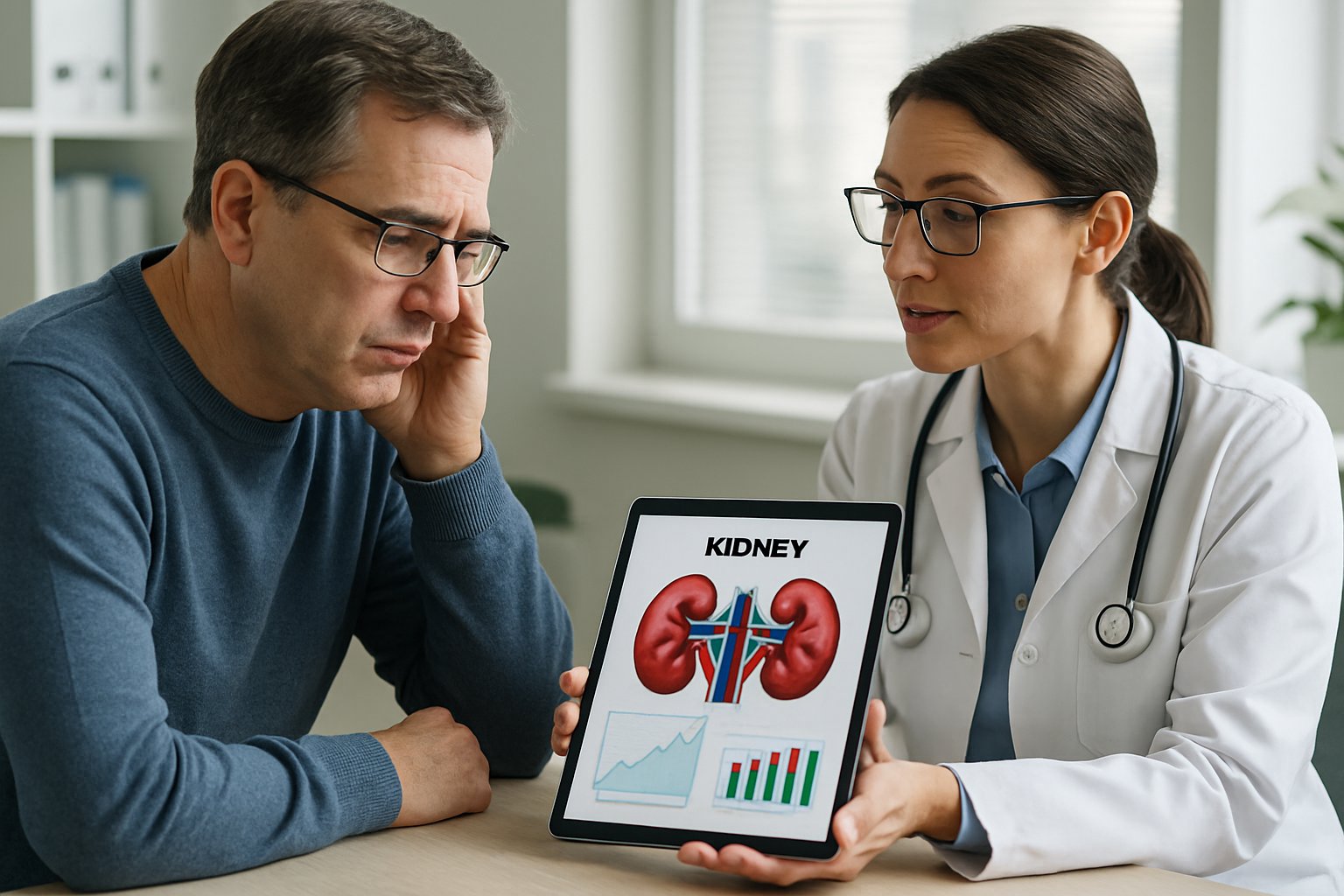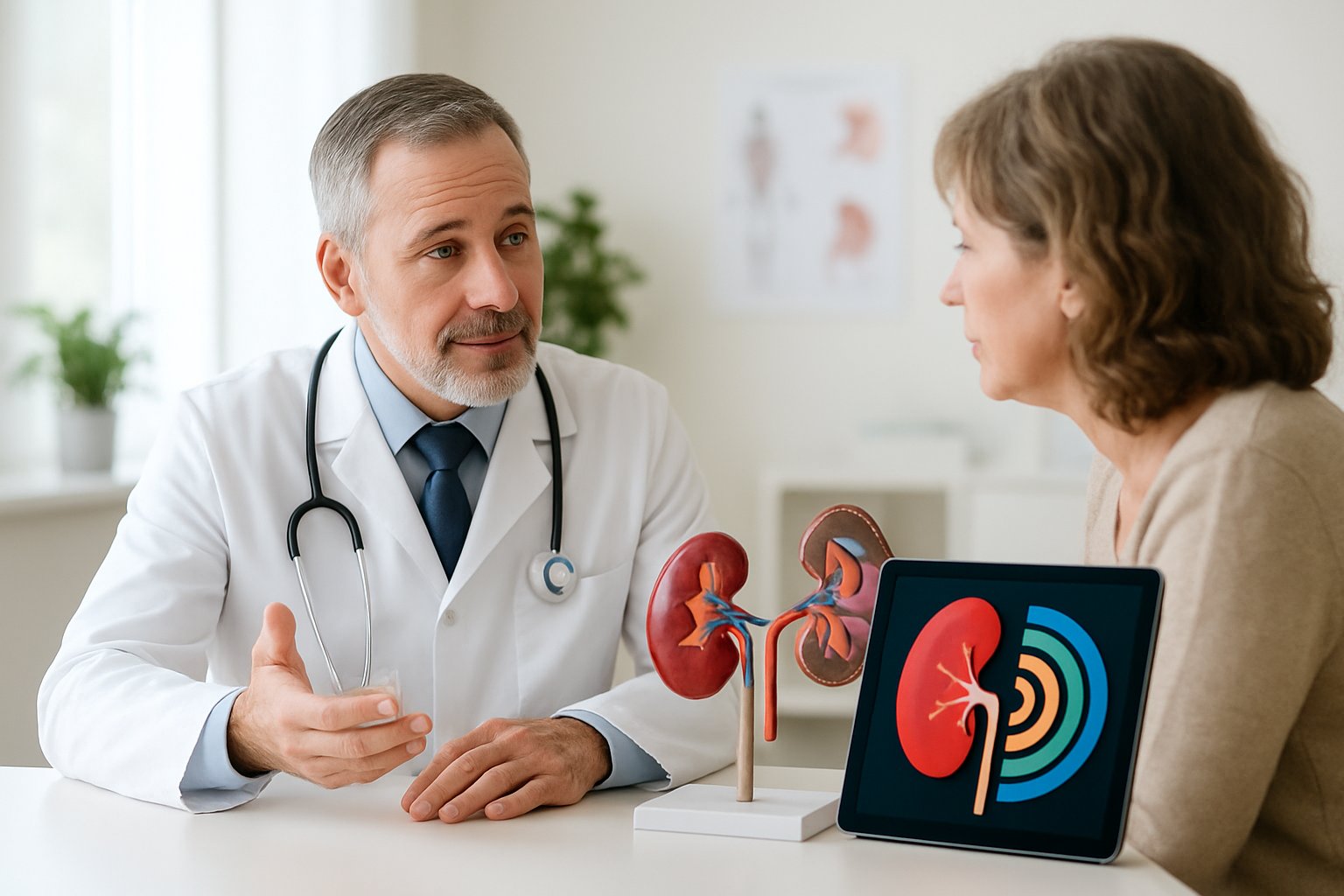A slightly low eGFR may be normal aging rather than kidney disease, especially after age 40. Symptoms typically don’t appear until eGFR drops below 20-25, so many people feel fine with mildly low readings. Controlling blood pressure, blood sugar, and following a kidney-friendly diet can help protect kidney function.
A low eGFR reading can be concerning, but whether you should worry depends on several factors including your age, overall health, and how low the numbers are. Most people with mildly low eGFR levels, especially those over 40, may not need to panic since kidney function naturally declines with age.

The eGFR test measures how well your kidneys filter waste from your blood. When results come back lower than normal, it could signal kidney disease or simply reflect normal aging. Most patients will not have symptoms unless eGFR falls below about 20-25[1], which means many people with slightly low readings feel completely fine.
Understanding what your specific eGFR numbers mean and taking steps to protect your kidney health can help you make informed decisions about your care. The key is knowing when to take action and what lifestyle changes can help slow any potential kidney damage.
What Does a Low eGFR Mean?

A low eGFR indicates reduced kidney function and serves as a key marker for chronic kidney disease. The calculation uses blood creatinine levels along with age and gender, though several factors can affect accuracy.
How eGFR Is Calculated
The estimated glomerular filtration rate uses serum creatinine level, age, and sex[2] to determine how well kidneys filter waste from blood. Healthcare providers rely on this calculation during routine blood tests.
The most common formula is the CKD-EPI equation. It takes a person’s creatinine level and adjusts for age, gender, and race. Creatinine is a waste product that healthy kidneys normally filter out.
Some labs also use cystatin C levels instead of or alongside creatinine measurements. This provides a more accurate reading in certain patients where creatinine alone may not reflect true kidney function.
The eGFR result shows how many milliliters of blood the kidneys can filter per minute. Normal kidneys filter about 90-120 mL/min/1.73m².
Normal Ranges and CKD Stages
Doctors use eGFR ranges to classify kidney disease into five stages. Each stage indicates different levels of kidney function decline.
CKD Stages by eGFR:
- Stage 1: eGFR 90+ (normal with kidney damage)
- Stage 2: eGFR 60-89 (mild decrease)
- Stage 3a: eGFR 45-59 (moderate decrease)
- Stage 3b: eGFR 30-44 (moderate decrease)
- Stage 4: eGFR 15-29 (severe decrease)
- Stage 5: eGFR under 15 (kidney failure)
An eGFR below 60 for three months or longer indicates chronic kidney disease. The National Kidney Foundation considers this the point where kidney function becomes significantly impaired.
Protein in urine tests often accompany eGFR measurements. This combination helps doctors better assess overall kidney health and disease progression.
Factors Affecting eGFR Accuracy
Several factors can cause eGFR readings to be higher or lower than actual kidney function. Understanding these limitations helps interpret results correctly.
Muscle mass significantly affects creatinine levels. People with more muscle produce more creatinine, which can make eGFR appear lower than actual function. Athletes and bodybuilders often show falsely low readings.
Age and gender naturally influence creatinine production. Older adults and women typically have less muscle mass, potentially showing higher eGFR values than true function.
Medications like ACE inhibitors can temporarily lower eGFR without indicating permanent kidney damage. Recent illness, dehydration, or high protein intake also affect creatinine levels.
Race-based adjustments in traditional formulas have become controversial. Many labs now report eGFR without race-based modifications following guidance from the American Society of Nephrology.
Doctors often repeat blood tests and consider multiple factors before diagnosing kidney disease based on eGFR alone.
Potential Causes and Risks of Low eGFR
Low eGFR results from both temporary and permanent kidney problems, ranging from dehydration to chronic kidney disease[1]. Understanding whether kidney damage is reversible or progressive helps determine the urgency of treatment and long-term health risks.
Chronic Kidney Disease Versus Acute Kidney Injury
Chronic kidney disease develops slowly over months or years, while acute kidney injury (AKI) happens suddenly within days or weeks. CKD causes permanent kidney damage that worsens over time. AKI may be reversible if treated quickly.
Chronic Kidney Disease Characteristics:
- Progressive loss of kidney function
- Usually no symptoms until eGFR drops below 25
- Common causes include diabetes and hypertension[1]
- Can lead to kidney failure requiring dialysis
Acute Kidney Injury Features:
- Sudden drop in kidney function
- Often caused by dehydration, infections, or medications
- May cause swelling, fatigue, and changes in urination
- Can be reversible with proper treatment
CKD patients face long-term risks including anemia, bone disease, and cardiovascular problems. AKI patients may recover full kidney function if the underlying cause is treated promptly.
Common Medical and Lifestyle Causes
Several medical conditions and lifestyle factors contribute to low eGFR readings. Diabetes and high blood pressure are leading causes of kidney disease[1].
Medical Conditions:
- Diabetes: High blood sugar damages kidney blood vessels
- Hypertension: High blood pressure harms kidney filters
- Liver disease: Affects kidney function and eGFR calculations
- Heart disease: Reduces blood flow to kidneys
Lifestyle Factors:
- High muscle mass: Can falsely lower eGFR readings
- Smoking: Damages blood vessels and reduces kidney function
- Excessive alcohol consumption: Causes dehydration and kidney stress
- Low physical activity: Contributes to diabetes and hypertension
Temporary Factors:
- Dehydration from illness or inadequate fluid intake
- Certain medications like NSAIDs or ACE inhibitors
- Pregnancy can affect eGFR calculations
People with protein in urine face higher risks of kidney disease progression. Fluid retention and swelling often indicate more advanced kidney problems.
When to Seek Specialist Evaluation
Patients should consult a kidney specialist when eGFR remains consistently low or continues declining. Early specialist care helps slow kidney disease progression and prevents complications.
Immediate Specialist Referral Needed:
- eGFR below 30
- Rapid decline in kidney function
- Protein in urine with low eGFR
- Symptoms like fatigue, shortness of breath, or ankle swelling[1]
Consider Specialist Consultation:
- eGFR between 30-60 with other risk factors
- Family history of kidney disease
- Diabetes or hypertension with declining eGFR
- Recurrent kidney infections or stones
Specialists can identify specific causes like inherited kidney diseases or autoimmune conditions. They provide targeted treatments to slow kidney damage and manage complications like anemia and bone disease.
Early specialist involvement helps patients avoid kidney failure and the need for dialysis or transplantation.
Symptoms and Health Effects of Low eGFR

Low eGFR typically causes no symptoms in early stages, but as kidney function drops below 20-25, people experience fatigue, swelling, and breathing problems. Advanced kidney disease can lead to serious complications like anemia, bone disease, and fluid retention throughout the body.
Early and Advanced Symptoms
Most people with mildly low eGFR feel completely normal. Symptoms rarely appear unless eGFR falls below 20-25[1], which indicates advanced kidney disease.
Early symptoms include:
- Fatigue and weakness
- Swelling in ankles and feet
- Loss of appetite
- Mild shortness of breath
As kidney function worsens, more severe symptoms develop. People may experience persistent itching as waste builds up in their blood. Muscle cramps become common, especially at night.
Fluid retention causes swelling to spread beyond the ankles to legs, hands, and face. Breathing becomes harder as fluid accumulates around the lungs.
Sleep problems and difficulty concentrating affect daily life. Nausea and vomiting may occur as toxins accumulate.
Impacts on Overall Health
Low eGFR affects multiple body systems beyond the kidneys. Anemia develops because damaged kidneys produce less of a hormone that helps make red blood cells. This causes additional fatigue and weakness.
Bone disease occurs as kidneys lose their ability to process vitamin D and control calcium levels. Bones become weak and break more easily.
High blood pressure worsens as kidneys struggle to remove excess fluid and sodium. This creates a cycle where high blood pressure damages kidneys further.
Heart problems increase significantly. The extra work of pumping fluid-overloaded blood strains the heart muscle.
Without treatment, severe eGFR decline leads to kidney failure. At this stage, dialysis or transplant becomes necessary for survival. Healthy kidneys filter about 120-150 milliliters per minute, but kidney failure means this drops below 15.
How to Protect and Support Your Kidney Health

Taking steps to protect kidney function can slow disease progression and delay the need for dialysis or transplant. Key strategies include controlling blood pressure and diabetes, following a kidney-friendly diet, staying properly hydrated, and avoiding harmful medications.
Managing Blood Pressure and Diabetes
High blood pressure and diabetes are the leading causes of kidney damage. These conditions harm the tiny filters in the kidneys over time.
Blood Pressure Control
People with kidney disease should aim for blood pressure below 130/80 mmHg. ACE inhibitors and ARBs are often the first choice medications because they provide extra kidney protection.
SGLT2 inhibitors offer additional benefits for people with diabetes and kidney disease. These medications help control blood sugar while protecting kidney function.
Blood Sugar Management
People with diabetes should maintain an A1C level below 7% when possible. Regular blood sugar monitoring helps prevent further kidney damage.
Taking prescribed medications consistently is essential. Skipping doses can lead to dangerous spikes in blood pressure or blood sugar.
Healthy Diet and Hydration
A kidney-friendly diet focuses on limiting sodium, managing protein intake, and choosing nutrient-rich foods. The specific dietary needs vary based on kidney function levels.
Sodium and Protein Guidelines
Most people with kidney disease should limit sodium to less than 2,300 mg per day. Reducing processed foods, canned goods, and restaurant meals helps achieve this goal.
Protein needs depend on kidney disease stage. People with advanced kidney disease may need to limit protein to 0.8 grams per kilogram of body weight.
Plant-Based Nutrition
A kidney-friendly diet[3] emphasizes fruits, vegetables, legumes, and whole grains. The DASH diet provides a good framework for kidney health.
Plant-based foods are typically lower in phosphorus and potassium than animal proteins. This helps reduce kidney workload.
Hydration Needs
Proper hydration supports kidney function, but needs vary by individual. People with early-stage kidney disease should avoid dehydration.
Those with advanced kidney disease or heart problems may need fluid restrictions. A healthcare provider can determine appropriate daily fluid intake.
Medications and Substances to Avoid
Certain medications and substances can harm kidney function or worsen existing damage. NSAIDs like ibuprofen and naproxen[3] pose particular risks when used regularly.
Pain Medication Alternatives
Acetaminophen is generally safer for kidneys than NSAIDs. Topical pain relievers and patches provide alternatives for managing discomfort.
People should always check with their healthcare provider before taking new medications. Even over-the-counter supplements can affect kidney function.
Substance Use Considerations
Smoking damages blood vessels throughout the body, including those in the kidneys. Quitting smoking[3] can slow kidney damage progression.
Excessive alcohol consumption can worsen high blood pressure and interfere with diabetes management. Moderate alcohol intake or abstinence is recommended.
Lifestyle Modifications for Kidney Protection
Regular physical activity, maintaining a healthy weight, and managing stress support overall kidney health. These changes work together to reduce disease progression.
Exercise Benefits
Physical activity helps control blood pressure and blood sugar[3] while improving heart health. These benefits directly support kidney function.
Most adults should aim for at least 150 minutes of moderate exercise weekly. Walking, swimming, and cycling are kidney-friendly options.
Weight Management
Obesity increases the risk of diabetes and hypertension, which can accelerate kidney damage. Losing even small amounts of weight can provide benefits.
A healthy weight reduces strain on the kidneys and helps control blood pressure. Combined dietary changes and physical activity offer the best results.
Additional Considerations
Adequate vitamin D levels support bone health, which becomes important as kidney function declines. Regular blood tests can monitor vitamin D status.
Getting enough sleep and managing stress help maintain healthy blood pressure levels. These factors contribute to overall kidney protection strategies.
Frequently Asked Questions
People with low eGFR often have questions about what causes kidney decline and whether their condition can improve. Understanding the factors that affect kidney function and the symptoms to watch for helps patients make informed decisions about their health.
What factors may cause a decline in glomerular filtration rate over time?
Diabetes and high blood pressure are the leading causes of kidney disease[3]. These conditions damage the tiny filters in the kidneys when not properly controlled.
Other medical conditions can also reduce GFR over time. Common causes include glomerulonephritis, vascular disease, and inherited kidney diseases like polycystic kidney disease and Alport syndrome[1].
Lifestyle factors contribute to kidney function decline as well. Smoking damages blood vessels in the kidneys. Taking too many over-the-counter pain medications like ibuprofen can harm kidney function.
Is it possible to maintain kidney health despite having a consistently low GFR?
Yes, people can slow kidney damage even with low GFR numbers. The key is managing underlying health conditions and making lifestyle changes.
Controlling blood sugar and blood pressure helps prevent further kidney damage[3]. Taking medications as prescribed and checking these numbers regularly is important.
Regular exercise supports kidney health by lowering blood pressure and controlling blood sugar. Physical activity also improves heart health, which benefits the kidneys.
How does age affect normal GFR levels?
Age naturally affects what doctors consider normal GFR levels. Kidney function typically decreases as people get older.
A GFR of 60-100 is generally considered normal, depending on age and gender[4]. Older adults may have slightly lower normal ranges than younger people.
Doctors account for age when interpreting GFR results. They look at the overall pattern over time rather than focusing on single test results.
What dietary choices could contribute to an improvement in GFR?
A kidney-friendly diet focuses on limiting sodium, saturated fats, and added sugars[3]. These changes can help slow kidney damage and support remaining function.
Eating more plant-based foods benefits kidney health. Fruits, vegetables, legumes, and whole grains are good choices for most people with kidney disease.
Cutting back on red meat and avoiding salty, canned, or frozen foods helps reduce kidney stress[3]. A kidney dietitian can create a personalized eating plan.
Proper hydration matters, but fluid needs vary by person. People with early kidney disease should avoid dehydration, while those with advanced disease may need to limit fluids.
What symptoms might indicate a decrease in kidney function associated with a low GFR?
Many people with decreased kidney function do not notice symptoms until GFR drops significantly. Most people don’t have symptoms until GFR reaches 20-30 or lower[4].
Some people don’t feel sick until GFR drops to 10-15[4]. This is why regular blood testing is important for people at risk.
When symptoms do appear, they may include fatigue, swelling in legs or ankles, changes in urination, nausea, or loss of appetite. Shortness of breath and trouble concentrating can also occur.
Can kidney function improve after experiencing a low eGFR, and under what circumstances?
eGFR numbers can sometimes improve, especially if kidney damage is caught early. eGFR numbers may go up or down slightly between tests, which is normal[2].
Acute kidney injury may be reversible if treated quickly. This happens when kidneys are temporarily damaged by infection, dehydration, or certain medications.
Chronic kidney disease is usually not reversible, but its progression can be slowed significantly. Managing diabetes, controlling blood pressure, and making lifestyle changes can help preserve remaining kidney function.
The pattern of eGFR over time matters more than single test results[2]. Doctors look for trends rather than focusing on individual numbers.
References
- My eGFR is below normal: Do I have a kidney disease?. https://www.topdoctors.co.uk/medical-articles/my-egfr-is-below-normal-do-i-have-a-kidney-disease/ Accessed October 24, 2025
- Can my GFR get better?. https://www.kidney.org/kidney-topics/can-my-gfr-get-better Accessed October 24, 2025
- Low eGFR Explained: 6 Tips to Slow Kidney Damage and Stay Healthy. https://www.kidney.org/news-stories/can-you-improve-your-egfr-what-science-says Accessed October 24, 2025
- Most Common Questions Kidney Patients Ask Doctors. https://www.davita.com/education/kidney-disease/symptoms/most-common-questions-kidney-patients-ask-doctors Accessed October 24, 2025
